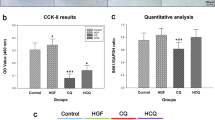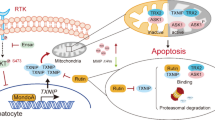Abstract
Osthole is a natural coumarin substance that has an inhibitory effect on hepatic cancer, but its radiosensitization effect on hepatoma cells has not been reported. This study aimed to investigate the effect of osthole. Human HCC-LM3 and SK-Hep-1 hepatoma cells were used and treated with or without osthole, irradiation, or their combination; the cell survival, migration, colony formation, DNA damage repair, intracellular lactic acid content, and glycolysis-related glycogen synthase kinase-3β (GSK-3β), p-GSK-3β, AMP-activated protein kinase (AMPK), p-AMPK, mammalian target of rapamycin (mTOR), p-mTOR, glucose transporter-1 (GLUT-1), GLUT-3, and pyruvate kinase isozyme type M2 (PKM2) protein expressions were determined. Compared with the irradiation group, the osthole plus irradiation group could further decrease the survival rate, migration, colony formation, and DNA damage repair of both hepatoma cells, indicating a synergistic effect of the combination treatment. Moreover, the combination of osthole and irradiation could decrease the content of intracellular lactic acid, ratios of intracellular p-GSK-3β/GSK-3β and p-mTOR/mTOR proteins, and expressions of intracellular GLUT-1/3 and PKM2 proteins, and increase the ratio of intracellular p-AMPK/AMPK proteins. Osthole can increase the radiosensitivity of hepatoma cells, and its radiosensitization mechanisms may be related to glycolytic inhibition by attenuating the GSK-3β/AMPK/mTOR pathway.





Similar content being viewed by others
Data availability
The data will be made available upon reasonable request.
References
Alves AP, Mamede AC, Alves MG, Oliveira PF, Rocha SM, Botelho MF, Maia CJ (2019) Glycolysis inhibition as a strategy for hepatocellular carcinoma treatment? Curr Cancer Drug Targets 19:26–40
Bae H, Lee JY, Song J, Song G, Lim W (2021) Osthole interacts with an ER-mitochondria axis and facilitates tumor suppression in ovarian cancer. J Cell Physiol 236:1025–1042
Bhatt AN, Chauhan A, Khanna S, Rai Y, Singh S, Soni R, Kalra N, Dwarakanath BS (2015) Transient elevation of glycolysis confers radio-resistance by facilitating DNA repair in cells. BMC Cancer 15:335
Che YL, Li J, Li ZJ, Li J, Wang S, Yan Y, Zou K, Zou LJ (2018) Osthole enhances antitumor activity and irradiation sensitivity of cervical cancer cells by suppressing ATM/NF-κB signaling. Oncol Rep 40:737–747
Chen CP (2019) Role of radiotherapy in the treatment of hepatocellular carcinoma. J Clin Transl Hepatol 7:183–190
Chen ZQ, Xie H, Hu MM, Huang TY, Hu YN, Sang N, Zhao YL (2020) Recent progress in treatment of hepatocellular carcinoma. Am J Cancer Res 10:2993–3036
Fan H, Wu YY, Yu SY, Li XM, Wang AY, Wang SJ, Chen WX, Lu Y (2021) Critical role of mTOR in regulating aerobic glycolysis in carcinogenesis (Review). Int J Oncol 58(1):9–19
Fang GX, Zhang PL, Liu JF, Zhang X, Zhu XJ, Li R, Wang HY (2019) Inhibition of GSK-3β activity suppresses HCC malignant phenotype by inhibiting glycolysis via activating AMPK/mTOR signaling. Cancer Lett 463:11–26
Faubert B, Boily G, Izreig S, Griss T, Samborska B, Dong ZF, Dupuy F, Chambers C, Fuerth BJ, Viollet B, Mamer OA, Avizonis D, DeBerardinis RJ, Siegel PM, Jones RG (2013) AMPK is a negative regulator of the Warburg effect and suppresses tumor growth in vivo. Cell Metab 17:113–124
Guo L, Chen D, Yin X, Shu QF (2019) GSK-3 beta promotes cell migration and inhibits autophagy by mediating the AMPK pathway in breast cancer. Oncol Res 27:487–494
Hirschhaeuser F, Sattler UG, Mueller-Klieser W (2011) Lactate: a metabolic key player in cancer. Cancer Res 71:6921–6925
Huang CY, Hsieh FS, Wang CY, Chen LJ, Chang SS, Tsai MH, Huang MH, Kuo CW, Shih CT, Chao T, Chen KF (2018) Palbociclib enhances radiosensitivity of hepatocellular carcinoma and cholangiocarcinoma via inhibiting ataxia telangiectasia-mutated kinase-mediated DNA damage response. Eur J Cancer 102:10–22
Huangfu MJ, Wei RM, Wang J, Qin JL, Yu D, Guan X, Li XM, Fu ML, Liu HP, Chen X (2021) Osthole induces necroptosis via ROS overproduction in glioma cells. FEBS Open Bio 11:456–467
Jia CH, Zhao Y, Huang H, Fan K, Xie T, Xie ML (2022) Apigenin sensitizes radiotherapy of mouse subcutaneous glioma through attenuations of cell stemness and DNA damage repair by inhibiting NF-κB/HIF-1α-mediated glycolysis. J Nutr Biochem 107:109038
Lee WH, Lin RJ, Lin SY, Chen YC, Lin HM, Liang YC (2011) Osthole enhances glucose uptake through activation of AMP-activated protein kinase in skeletal muscle cells. J Agric Food Chem 59:12874–12881
Lin JT, Song T, Li C, Mao WF (2020) GSK-3β in DNA repair, apoptosis, and resistance of chemotherapy, radiotherapy of cancer. Biochim Biophys Acta Mol Cell Res 1867:118659
Lin SC, Hardie DG (2018) AMPK: sensing glucose as well as cellular energy status. Cell Metab 27:299–313
Lin ZK, Liu J, Jiang GQ, Tan G, Gong P, Luo HF, Li HM, Du J, Ning Z, Xin Y, Wang ZY (2017) Osthole inhibits the tumorigenesis of hepatocellular carcinoma cells. Oncol Rep 37:1611–1618
Liu KX, Everdell E, Pal S, Haas-Kogan DA, Milligan MG (2021) Harnessing lactate metabolism for radiosensitization. Front Oncol 11:672339
Mo Y, Wu Y, Li X, Rao H, Tian XX, Wu DN, Qiu ZP, Zheng GH, Hu JJ (2020) Osthole delays hepatocarcinogenesis in mice by suppressing AKT/FASN axis and ERK phosphorylation. Eur J Pharmacol 867:172788
Nagini S, Sophia J, Mishra R (2019) Glycogen synthase kinases: moonlighting proteins with theranostic potential in cancer. Semin Cancer Biol 56:25–36
Park W, Park S, Song G, Lim W (2019) Inhibitory effects of osthole on human breast cancer cell progression via induction of cell cycle arrest, mitochondrial dysfunction, and ER stress. Nutrients 11(11):2777
Peng L, Huang YT, Chen J, Zhuang YX, Zhang F, Chen JY, Zhou L, Zhang DH (2018) Osthole sensitizes with radiotherapy to suppress tumorigenesis of human nasopharyngeal carcinoma in vitro and in vivo. Cancer Manag Res 10:5471–5477
Pliszka M, Szablewski L (2021) Glucose transporters as a target for anticancer therapy. Cancers 13(16):4184
Qi ZG, Zhao X, Zhong W, Xie ML (2016) Osthole improves glucose and lipid metabolism via modulation of PPARα/γ-mediated target gene expression in liver, adipose tissue, and skeletal muscle in fatty liver rats. Pharm Biol 54:882–888
Shokoohinia Y, Jafari F, Mohammadi Z, BazvandiL HL, Chow N, Bhattacharyya P, Farzaei MH, Farooqi AA, Nabavi SM, Yerer MB, Bishayee A (2018) Potential anticancer properties of osthol: a comprehensive mechanistic review. Nutrients 10(1):36
Tang L, Wei F, Wu YF, He Y, Shi L, Xiong F, Gong ZJ, Guo C, Li XY, Deng H, Cao K, Zhou M, Xiang B, Li XL, Li Y, Li GY, Xiong W, Zeng ZY (2018) Role of metabolism in cancer cell radioresistance and radiosensitization methods. J Exp Clin Cancer Res 37:87
Yang XG, Lu Y, Hang JJ, Zhang JF, Zhang TN, Hou YM, Liu J, Lai ST, Luo DW, Wang LW, Hua R, Lin YL (2020) Lactate-modulated immunosuppression of myeloid-derived suppressor cells contributes to the radioresistance of pancreatic cancer. Cancer Immunol Res 8:1440–1451
Yu L, Sun YF, Li JJ, Wang Y, Zhu YX, Shi Y, Fan XJ, Zhou JD, Bao Y, Xiao J, Cao K, Cao PG (2017) Silencing the girdin gene enhances radio-sensitivity of hepatocellular carcinoma via suppression of glycolytic metabolism. J Exp Clin Cancer Res 36:110
Zahra K, Dey T, Ashish MSP, Pandey U (2020) Pyruvate kinase M2 and cancer: the role of PKM2 in promoting tumorigenesis. Front Oncol 10:159
Zhao Y, Huang H, Jia CH, Fan K, Xie T, Zhu ZY, Xie ML (2021) Apigenin increases radiosensitivity of glioma stem cells by attenuating HIF-1α-mediated glycolysis. Med Oncol 38:131
Funding
This work was supported by the Science & Technology Project of Suzhou City for Medical Health (KJXW2020039), Research Fund of Nanjing Medical University (NMUB2020254), and Research Program of Gusu School of Nanjing Medical University (GSKY20220526), China.
Author information
Authors and Affiliations
Contributions
HH and XJ performed the cell experimental study. HH analyzed the experimental data and drafted the manuscript. XJ revised the manuscript. XT and XML designed the study and reviewed the manuscript. All the authors read and approved the final version of the manuscript. The authors declare that all the data were generated in-house and that no paper mill was used.
Corresponding authors
Ethics declarations
Competing interests
The authors declare no competing interests.
Additional information
Publisher's note
Springer Nature remains neutral with regard to jurisdictional claims in published maps and institutional affiliations.
Rights and permissions
Springer Nature or its licensor (e.g. a society or other partner) holds exclusive rights to this article under a publishing agreement with the author(s) or other rightsholder(s); author self-archiving of the accepted manuscript version of this article is solely governed by the terms of such publishing agreement and applicable law.
About this article
Cite this article
Huang, H., Xue, J., Xie, T. et al. Osthole increases the radiosensitivity of hepatoma cells by inhibiting GSK-3β/AMPK/mTOR pathway-controlled glycolysis. Naunyn-Schmiedeberg's Arch Pharmacol 396, 683–692 (2023). https://doi.org/10.1007/s00210-022-02347-8
Received:
Accepted:
Published:
Issue Date:
DOI: https://doi.org/10.1007/s00210-022-02347-8




